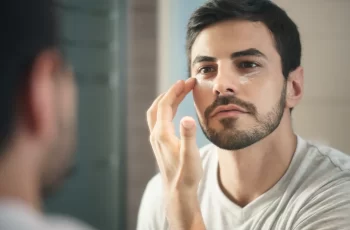A Dermatologist Shares Their Skincare Resolutions For ‘25
2025 is shaping up to be my year of radiant skin, and I can feel the positive changes coming. As a dermatologist with a diverse range of responsibilities (including practising dermatology and being a mum) finding the time for my skincare rituals can be a challenge. Despite having a wealth of tools and knowledge, achieving my best skin often slips through the cracks. This year, my resolution is to make small but impactful commitments to prioritise my skin health.
Here are my skin goals for 2025. I’m excited for the journey ahead. Wish me luck!
Retinol cycling.
Retinol stands out as one of the few actives backed by data, to support its anti-ageing claims. Being in my 40s, I’m no stranger to the benefits of retinol, and in 2025, I plan to really focus on integrating it into my skincare routine. Reserved exclusively for evening use, I plan to implement a retinol cycling strategy. This involves alternating between various strengths to optimise cellular renewal.
By switching brands at the end of each use and adjusting strengths, I aim to shield my skin from environmental damage and stave off visible signs of ageing. I’ll be exploring familiar strengths, like 1%, starting gradually, and progressively increasing frequency as the months unfold. It’s a deliberate and thoughtful approach to elevate my skincare routine in the coming year.
Maintaining a regular laser protocol.
In the realm of skincare technology, I’m fortunate to have access to cutting-edge lasers through my clinic, ODE Dermatology. As a dedicated dermatologist, I advocate passionately for laser protocols and personalised rituals for my clients every day. However, I must admit, I’ve been inconsistent in applying this expertise to my own skincare routine, often struggling to find time for a consistent treatment plan as life unfolds.
But 2025 marks a change for me – I’m prioritising self-care as I recommend for any client. Identifying key concerns like visible signs of ageing (goodbye, collagen loss) and dealing with melasma on my cheeks, I’ve crafted a 12-month plan just for myself. With a mix of non-ablative lasers like Moxi 1927 and collagen-inducing and hyaluronic-stimulating protocols such as Ultraformer and Exion, I’m committed to nurturing my skin back to its radiant days. It’s time to give myself the same level of care I provide to others.
No laser protocol journey is truly comprehensive without incorporating at-home care as well; tailored skincare, designed to address your specific concerns and skin type, plays a pivotal role in maximising the effectiveness of in-clinic treatments. This approach ensures that post-laser skin not only heals but also receives the nourishment and optimization needed for a healthy and radiant barrier. It’s the synergy of professional treatments and personalised at-home care that brings out the best in your skin.
Skincare, but for hair.
I am deeply dedicated to hair care, whether it’s regenerating hair growth, preventing hair loss, or addressing complex cases involving autoimmune conditions. One aspect often overlooked by many of my clients is the significance of the skin on their scalp and its impact on overall hair health. During 2024, a major focus for me is going to be optimising my scalp microbiome to ensure the best possible hair growth, health, and quality.
I like to think of the skin around the follicle as akin to the soil in which a plant thrives. Its quality profoundly influences prosperity, and it’s a message I’m eager to share widely. My skincare routine is evolving to prioritise scalp health, carefully considering what products I incorporate (or exclude) in my daily and weekly rituals. In the coming year, my go-to’s will include calendula, rosemary, and burdock root. These, coupled with essential fatty acids and phytosterols, aim to nourish the scalp and foster optimal hair growth. It’s time to elevate our awareness about the holistic connection between scalp health and vibrant, thriving hair.
Dr. Shammi Theesan is an esteemed dermatologist based in Fitzroy, Melbourne, and the visionary founder of ODE Dermatology. With a commitment to delivering transformative results, Dr. Theesan seamlessly merges the realms of science and traditional wellness measures. Her approach embodies a harmonious blend of cutting-edge dermatological practices and time-honoured holistic wellness, providing a unique and effective path to skin health.
DQH Knowledge drop: In your 20s, your skin cell turnover decreases. (Cell turnover is a key component in keeping your skin youthful.) You know what else slows down? Your collagen production. Starting in your 20s, collagen decreases by about 1 percent per year. Should you want to prevent fine lines and wrinkles, start by eliminating behaviors that contribute to premature aging. “If it’s bad for you, it’s bad for your skin,” says dermatologist Michel Somenek.
“Cigarette smoking reduces blood flow to the skin and causes premature wrinkling and a dull skin texture. Making the repeated pursed motion to inhale can also cause smoker’s lines. Alcohol and recreational drugs are toxins for the skin that damage its cellular structure and DNA,” Somenek tells us. “The faster you eliminate vices while you are young, the better chance your skin and body have to recuperate.” Also, adopting an anti-aging routine in your 20s is key. After all, the best offense is a good defense. We spoke to Somenek and experts Joshua Ross and Audrey Kunin to find out more.
Keep reading for the best anti-aging products for your 20s, according to skincare professionals.
Sunscreen
“We all know that the sun is the number one cause of skin aging and starting the prevention in your 20s is very important,” Ross says. “The majority of your sun damage won’t start to appear until you’re in your 30s, so don’t wait until you see it surface or you’ll be behind the curve. Stay ahead of it with a good-quality zinc-based sunscreen worn daily.”
Farmacy Green Defense Daily Mineral Sunscreen
An invisible sunscreen with SPF 30, plus botanical extracts meant to protect skin with tons of antioxidants. Bonus: It’s clean and fine to use under makeup.
Bareminerals Complexion Rescue™ Tinted Moisturizer Broad Spectrum SPF 30
Although we recommend you use your SPF and moisturizer separately, we also understand moments when you don’t have time or energy for that extra step. For those times, this bareMinerals moisturizer is a great thing to have on hand.
Vitamin C Serum
“A great introduction to anti-aging is to start with a vitamin C serum in your morning skincare routine,” Ross says. “It’s a powerful antioxidant that will neutralize free radicals and brighten the skin.” He adds that it’s a great way to counteract the effects of the sun’s harmful rays, which, as previously mentioned, are among the biggest causes of premature aging.
Drunk Elephant C-Firma™ Vitamin C Day Serum
The Drunk Elephant C-Firma is a lightweight serum that promises to give skin a glow by combining the brightening powers of vitamin C with ferulic acid, l-ascorbic acid, and vitamin E. The included sodium hyaluronate is meant to replace hydration loss, so you shouldn’t have to deal with any irritation.
Sunday Riley C.E.O. Rapid Flash Brightening Serum
This potent serum is jam-packed with vitamin C (15 percent, to be exact), which means it’s a potential superstar at both brightening skin and dousing it in antioxidants.
Peptides
Using peptides on your skin has many benefits, says Somenek. “The skin barrier is what defends the body against pollution, UV rays, bacteria, and toxins. It can be damaged by several everyday factors. Using topical peptides aids in building a stronger barrier,” he says. “Peptides comprise elastic fibers, which are a type of protein. These fibers help to make skin appear taut and firm. Peptides can also help repair damaged skin, relieve inflammation, and even out skin tone. Some peptides can kill acne-causing bacteria that is common in 20-somethings.”
Kunin agrees, saying, “Peptides are an excellent entry point for supporting collagen.” She recommends looking for face and eye treatments that contain these collagen-boosting powerhouses.
Charlotte Tilbury Magic Eye Rescue Cream
This Charlotte Tilbury super-emollient eye cream has a base of coconut oil and shea butter (read: it’s incredibly hydrating). Botanicals plus peptides are meant to help reduce dark circles and boost collagen, respectively.
This creamy moisturizer serves up potent collagen-boosting peptides and pycnogenol, and antioxidant-rich vitamin C. “Instead of sitting on top of the skin, peptides penetrate the outer layer so they go deep. The ‘signals’ they send tell the cells to produce elastin and collagen, which are needed for youthful-looking skin,” explains Somenek.
At-Home Peel Pads
Remember that skin cell turnover fiasco we talked about earlier? One way to help support it is by exfoliating. “Exfoliation is important to help keep skin fresh and luminous,” Kunin says. She recommends using at-home peel pads as an easy and effective way to exfoliate.
“The goal in your 20s is to fight the slowing pace of cell turnover. It is wise to use products that gently exfoliate, yet still remove oil and other impurities. Products that have Alpha Hydroxy Acids (AHA) or Beta Hydroxy Acids (BHA) are a good choice.”
According to Somenek, you should only exfoliate two to three times a week. “People of all ages are guilty of over-exfoliating and that can be too much of a good thing,” he says.
Dermadoctor Kakadu C Intensive Vitamin C Peel Pad
A few swipes of this Derma Doctor powerful peel pad promise to leave your skin glowing and smooth, thanks to the seven (yes, seven) types of chemical exfoliants, including AHA and BHA. It also contains vitamin C via Kakadu plum extract for added brightening and antioxidant protection.
KEY INGREDIENTS Kakadu plum extract is sourced from the Kakadu plum, a fruit grown in northern Australia. It contains vitamin C, which restores the skin’s natural barrier, increases collagen production, and soothes irritation.
Dr. Dennis Gross Skincare Alpha Beta® Universal Daily Peel Pads
These are the gold standard of peel pads, with a cult following and over 900 five-star reviews on Sephora. They’re easy to use and contain a blend of anti-aging exfoliating acids.
Emollient Night Cream
“In your 20s, you need to start upping the hydration in your skincare routine. You may have been cautious of over-moisturizing because of acne in your teens, but as you enter your 20s, your skin transitions and becomes drier,” Ross says. “I recommend an emollient night cream added into your evening skincare regimen.”
“Twenty-somethings need to make sure that they are not using creams that will clog their pores and cause excess oil production,” says Somenek. Opt for non-comedogenic products.
Cerave Skin Renewing Night Cream
One great choice is the CeraVe Skin Renewing Night Cream, which is a non-comedogenic night cream that leaves skin soft and glowy. It combines the moisturizing powers of ceramides and hyaluronic acid.
RoC Retinol Correxion Max Hydration Creme
“The best night cream ingredients contain retinol, benzoyl peroxide, and/or salicylic acid or hyaluronic acid. The goal is to moisturize, yet remove excess oil,” says Somenek. This Roc Retinol Correxion cream fits the bill as it contains both hyaluronic acid and retinol so it promises to moisturize while also being non-comedogenic.



